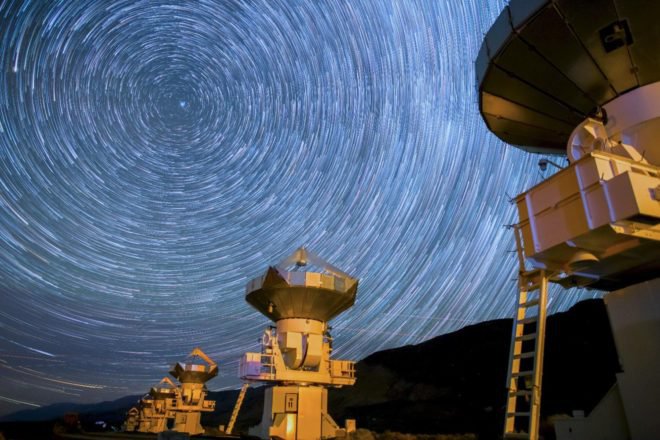
Dec. 2, 2016
Feature Story
SETI Reconceived and Broadened; A Call for Community Proposals

A screenshot from a time lapse video of radio telescopes by Harun Mehmedinovic and Gavin Heffernan of Sunchaser Pictures that was shot at several different radio astronomy facilities—the Very Large Array (VLA) Observatory in New Mexico, Owens Valley Observatory in Owens Valley California, and Green Bank Observatory in West Virginia. All three of these facilities have been or are still being partly used by the SETI (Search for the Extraterrestrial Intelligence) program.
Earlier this summer, Natalie Cabrol, the director of the Carl Sagan Center of the SETI Institute, described a new direction for her organization in Astrobiology Magazine, and I wrote a Many World column about the changes to come.
Cabrol’s “Alien Mindscapes – Perspective on the Search for Extraterrestrial Intelligence” laid out a plan for the new approach to SETI that would take advantage of the goldmine of new exoplanet discoveries in the past decade, as well as the data from fast-advancing technologies. These fresh angles and masses of information come, she wrote, from the worlds of astronomy and astrophysics, as well as astrobiology and the biological, geological, environmental, cognitive, mathematical, social, and computational sciences.
In her article, Cabrol said that a call would be coming for community input on how to develop a Virtual Institute for SETI Research. Its primary goal, she said, would be to “understand how intelligent life interacts with its environment and communicates.”
That call for white papers has now gone out in a release from SETI, which laid out the questions the organization is looking to address:
Question 1: How abundant and diverse is intelligent life in the Universe?
The Virtual Institute will use data synergistically from astrobiology, biological sciences, space and planetary exploration, and geosciences to quantitatively characterize the potential abundance and diversity of intelligent life in the Universe. The spatiotemporal distribution of potential intelligent life will be considered using models of the physicochemical evolution of the Universe.
Question 2: How does intelligent life communicate?
By drawing from a combination of cognitive sciences, neuroscience, communication and information theory, mathematical sciences, bio-neural computing, data mining, and machine learning (among others), we will proactively explore and analyze communication in intelligent terrestrial species. Building upon these analyses, we will consider the physiochemical and biochemical models of newly discovered exoplanet environments to generate and map probabilistic neural and homolog systems, and infer the resulting range of viable alien sensing systems.
Question 3: How can we detect intelligent life?
Using the results (data and databases) of research conducted under Questions 1 and 2, we will consider the design and promising exploration strategies, instruments, exploration strategies, instruments, experimental protocols, technologies, and messaging (content and support) that may optimize the probabilities of detecting intelligent life beyond Earth.
And here is what SETI hopes interested scientists will do:
To support the goals and address the questions outlined above, we seek white papers that will serve as a foundation for the intellectual framework of the Virtual Institute’s roadmap – and that specifically describe: (a) scientific rationales (theories, hypotheses) as foundations for investigations; (b) concepts of experimental designs (methods, protocols, and metrics); ( c) universal markers, signals, instruments, systems, technologies for communication; (d) target identification; and (e) ground- and space-based instrumentation, observing scenarios, instrument requirements, and exploration strategies.
To better understand the possible existence of intelligence and technology in the universe, and to learn how to detect it, we expect that proposals may draw from diverse scientific fields. These include astrobiology, astronomy/astrophysics, cognitive sciences, epistemology, geo- and environmental sciences, biosciences, mathematical sciences, social sciences, space sciences, communication theory, bioneural computing, machine learning, big data analytics, technology, instrument and software development, and other relevant fields.
White papers should be submitted in electronic form as PDF files to Dr. Nathalie Cabrol at ncabrol@seti.org. They should be no more than three pages in length, with a minimum 10-point font size. A figure can be included if of critical importance. It is anticipated that there will be an opportunity for interested respondents to present their contribution in person during a planned workshop in the summer of 2017.
Notification of opportunities to present will be made after the white paper deadline of February 17, 2017, and those most responsive to this call will be published in the Astrobiology Journal. Questions related to this call should be addressed to SETI Institute President and CEO Bill Diamond at bdiamond@seti.org.